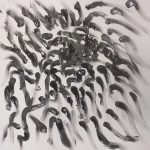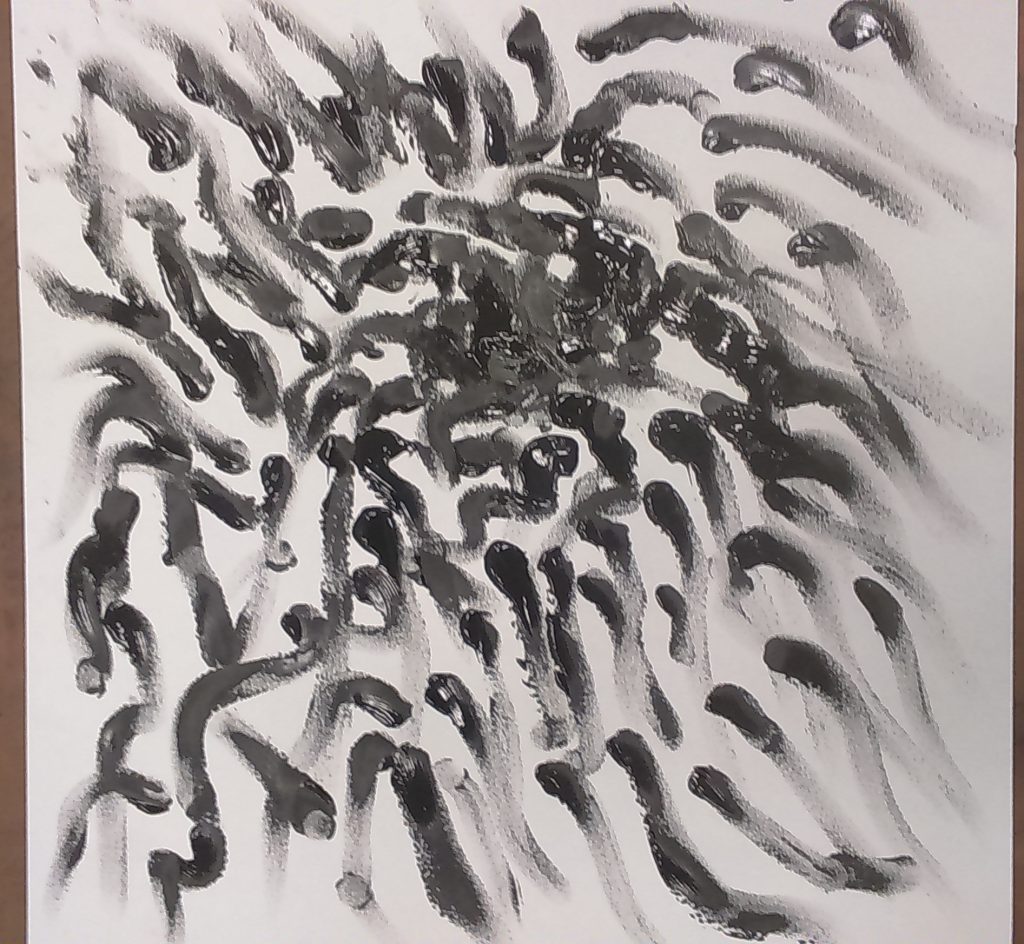https://docs.google.com/presentation/d/1yrljoPWlaMip7lkMIIeGCgogNfuk1NvyN4LPnvAvcyA/edit?usp=sharing
Month: September 2018
Project 1: Six Emotions Mark Making
Anger; a strong feeling of annoyance, displeasure, or hostility. Personally, anger is an emotion I suppressed inwardly. However, when a line is crossed and I lose my sense of self-control, anger comes out explosively. When this happens, regret is also felt for showing my temper. Interestingly, I don’t remember the reasons for getting angry.
Sorrow; a feeling of deep distress caused by loss, disappointment, or other misfortune suffered by oneself or others. Personally, sorrow comes together with the feeling of hatred against the object of disappointment. This object of disappointment is usually in the ‘self’. An intense struggle that reproaches the ‘self’ for the bad decisions made and done.
Anxiety; a feeling of worry, nervousness, or unease about something with an uncertain outcome. Personally, when I am anxious, my mind is busy with thoughts of the various ways and methods to rectify the root of my worries. In anxiety, there’s a focus of trying to fix the issue but at the cost of neglecting others.
Nostalgia; a sentimental longing or wistful affection for a period in the past. Personally, nostalgia gives me a warm fuzzy feeling of comfort even if I am the only who could recall that one particular memory among friends. It’s a good reminder as it brings to mind the importance of life.
Emotion #5: Confidence
Confidence; the feeling or belief that one can have faith in or rely on someone or something. Personally, confidence is being secure and firm even through the uncertainties of life. It comes from the hope to know that eventually all things will work out.
Serenity; the state of being calm, peaceful, and untroubled. Personally, the feeling of ease comes when I can relax around and do seemingly meaningless activities. However, serenity is often quick and temporal just like the calm before the storm as reality sets in with the busyness of life and there’s no time to relax.
Process & Reflection
For this emotion, a sponge is used to print the crosshatch patterns by stamping the sponge on its edge. A larger force is used to express a stronger and harsher emotion of anger. The soft surface of the sponge is also used to smudge the black paint to express the explosive nature of anger. The sponge is also used to gently smudge the crosshatching in a downward motion to express regret.
The sponge is used for this art piece. Similar to the art piece of anger a diagonal crosshatch pattern is created by stamping the sponge on its edge. Lesser force is used to achieve a lighter tone. The sponge is also used to smudge the crosshatching in an upwards motion to express a tinge of resentment.
Anxiety This art piece was created using my index finger as the tool for mark making. It was created without any plans and solely created based on the current state of emotion I was feeling which was anxiety. This was the last emotion of the six where I was anxious as I have ran out of inspiration to create the final emotion. In this current state of mind, I started smudging paint at one spot with my finger tip and started to leave more curvy strokes that is seemingly pointing towards the direction of the spot. I continue to add more curve strokes to represent the multiple activities of thoughts running in my mind in my state of anxiousness.
This art piece was created using my index finger as the tool for mark making. It was created without any plans and solely created based on the current state of emotion I was feeling which was anxiety. This was the last emotion of the six where I was anxious as I have ran out of inspiration to create the final emotion. In this current state of mind, I started smudging paint at one spot with my finger tip and started to leave more curvy strokes that is seemingly pointing towards the direction of the spot. I continue to add more curve strokes to represent the multiple activities of thoughts running in my mind in my state of anxiousness.
Nostalgia  A sponge is used in this emotion by printing the sponge on its smooth flat surface. One edge of the sponge is intentionally coated with more paint to create more distinctive vertical lines which represents the stability I felt in nostalgia. The prints of a sponge gives off a blurry texture which represents flashbacks and memories of the past.
A sponge is used in this emotion by printing the sponge on its smooth flat surface. One edge of the sponge is intentionally coated with more paint to create more distinctive vertical lines which represents the stability I felt in nostalgia. The prints of a sponge gives off a blurry texture which represents flashbacks and memories of the past.
Confidence The toothbrush was used to draw the diagonal lines on one half of the paper. The lines are intentionally drawn to create a triangle in the white area of the paper. The paper is folded into half to create a symmetry which represents order and a ‘X’ with a point of convergence at the center representing certainty and hope. The upside down triangle represents inbalance while the upright triangle represents stability and security I felt in uncertainties.
The toothbrush was used to draw the diagonal lines on one half of the paper. The lines are intentionally drawn to create a triangle in the white area of the paper. The paper is folded into half to create a symmetry which represents order and a ‘X’ with a point of convergence at the center representing certainty and hope. The upside down triangle represents inbalance while the upright triangle represents stability and security I felt in uncertainties.
This art piece was created by accident when I was trying to wipe of drops of ink on the table with a blank piece of paper. The smudges gave me an impression of calm due to the light tones. I used the toothbrush to add in ‘X’ marks in the empty spaces to represent hints of a storm beneath the calmness in my interpretation of serenity.
Conclusion
As a person who is used to do things by a systematic and logical manner, I found it challenging to think out of the box when it comes to art. I felt that there was always a limitation in creating an intentional art piece. From this project, I realised that the nature of art correlates with the nature of the artist. If the artist doesn’t venture out of his comfort zone, the art pieces he creates tends to be more rigid. Likewise, the emotion of the art piece the artist creates is reflecting of his emotion in his creation. I found that I liked and enjoyed the process of the creation of anxiety and serenity more so than the planned pieces of anger, sorrow, confidence and nostalgia. This project has indeed given me new perspective in approaching art.
Project 1 Research & Experimentation
Mark Making Tools:
 Toothbrush, Sponge & Index Finger
Toothbrush, Sponge & Index Finger
Experimentation of Tools:
 Toothbrush (Dark Tones)
Toothbrush (Dark Tones)
Experimentation of Emotion Creation:
 Negative Emotions
Negative Emotions
Research on Mark Making, Types of Lines, Shapes & Emotion:
Mark making describes the different lines, dots, marks, patterns, and textures we create in an artwork.
Mark making is used – in the form of separate brush marks or dabs of paint – to add life, movement and light to paintings. Artists working in an expressionist style such as Willem de Kooning also created representational artworks using mark making. In his Untitled drawing of 1966–7 de Kooning uses rough charcoal lines, marks and smudges to suggest the movement of the people he draws.
Action painters such as Jackson Pollock (who dripped and splashed paint onto his canvases)
Thin lines are fragile. They appear easy to break or knock over. They suggest frailty and convey an elegant quality. They are delicate and give off an ephemeral air.
Thick lines on the other hand appear difficult to break. They suggest strength and give emphasis to nearby elements. Thick lines are bold and make a statement.
Horizontal lines are parallel to the horizon (hence the name). They look like they’re lying down, at rest, asleep. They suggest calm and quiet, a relaxed comfort.
Vertical lines are perpendicular to the horizon. They are filled with potential energy that could be released if they were to fall over. Vertical lines are strong and rigid. They can suggest stability, especially when thicker.
Diagonal lines are unbalanced. They are filled with restless and uncontrolled energy. They can appear to be either rising or falling and convey action and motion.
Curved lines are softer than straight lines. They sweep and turn gracefully between end points. They are less definite and predictable than straight lines. They bend, they change direction. Curved lines express fluid movement.
Zigzag lines are a combination of diagonal lines that connect at points. They take on the dynamic and high energy characteristics of diagonal lines. They create excitement and intense movement. They convey confusion and nervousness as they change direction quickly and frequently.
Circles have no beginning or end. They suggest well-roundedness and completeness. Circles are graceful and their curves are seen as feminine. They are warm, comforting and give a sense of sensuality and love. Their movement suggests energy and power. Their completeness suggests the infinite, unity, and harmony.
Squares and rectangles are stable. They’re familiar and trusted shapes and suggest honesty. They have right angles and represent order, mathematics, rationality, and formality. Squares and rectangles suggest conformity, peacefulness, solidity, security, and equality. Their familiarity and stability, along with their commonness can seem boring.
Triangles can be stable when sitting on their base or unstable when not. They represent dynamic tension, action, and aggression. Triangles have energy and power and their stable/unstable dynamic can suggest either conflict or steady strength.
Spirals are expressions of creativity. They are often found in the natural growth pattern of many organisms and suggest the process of growth and evolution. Spirals convey ideas of fertility, birth, death, expansion, and transformation.
References:
Bradley, S. (2010, March 29) The Meaning of Lines: Developing A Visual Grammar. Retrieved from https://vanseodesign.com/web-design/visual-grammar-lines/.















